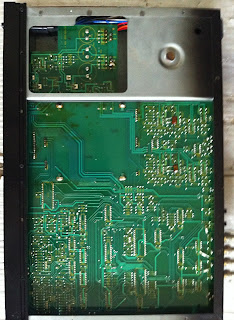The Sansui AU-9900A is one of all time favourite units. It is know as the AU-10000 in Japan. You can view many details pixs of the unit at the AMP8 (Japanese) site.
Unknown to many Sansui fans, the 9900A is one of the rare Class-A units produced by Sansui. I managed to locate the service manual which confirms via 50mV setting via adjustment of the trimmers on the main driver board.
I was not aware of the above until I managed to get a unit from eBay and paid for postage from the US. I initially though I bought a faulty unit when it was running warm and then hot!!! Had to get a dedicated fan to suck the hot air out before the exterior of the units was reasonable to touch!!! Unfortunately the fan is a little noisy ... (need to obtain a less noisy fan)
This is the pix under the covers.
You can see the original capacitors (some deformed) on the PSU board below. Please be aware of the bi-polar caps on the power board.
This is the original pre-amp driver board. Before re-cap, you could heard some raw-ness in the reproduction, especially on the high frequences.
 |
| Original pre-amp board |
 |
| Pre-amp board after re-cap |
The original AU9900A sounded so good I sold my AU-20000 (and kept the 9900A). The AU20000 was considered by many to be the top of the line integrated amp from Sansui!!!
The following is the pix of the main driver board after it was recapped. Took the opportunity to swap out some cheaper parts with better quality ones.











